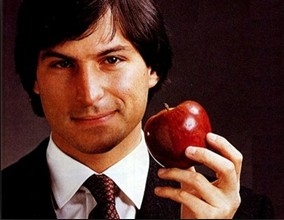CHAPTER FIVE
第五章
THE APPLE I
Apple I
Turn On, Boot Up, Jack In . . .
开机,启动,接入
Machines of Loving Grace
慈爱的机器
In San Francisco and the Santa Clara Valley during the late 1960s, various cultural currents flowed together. There was the technology revolution that began with the growth of military contractors and soon included electronics firms, microchip makers, video game designers, and computer companies. There was a hacker subculture—filled with wireheads, phreakers, cyberpunks, hobbyists, and just plain geeks—that included engineers who didn’t conform to the HP mold and their kids who weren’t attuned to the wavelengths of the subdivisions. There were quasi-academic groups doing studies on the effects of LSD; participants included Doug Engelbart of the Augmentation Research Center in Palo Alto, who later helped develop the computer mouse and graphical user interfaces, and Ken Kesey, who celebrated the drug with music-and-light shows featuring a house band that became the Grateful Dead. There was the hippie movement, born out of the Bay Area’s beat generation, and the rebellious political activists, born out of the Free Speech Movement at Berkeley. Overlaid on it all were various self-fulfillment movements pursuing paths to personal enlightenment: Zen and Hinduism, meditation and yoga, primal scream and sensory deprivation, Esalen and est.
20世纪60年代末,各种文化潮流在旧金山和硅谷交汇。技术革命伴随着军事承包商的发展而兴起,并迅速扩展到电子公司、微芯片制造商、视频游戏软件设计师和计算机公司。这里出现了黑客的亚文化群——云集于此的有资深玩家、电话飞客、电子朋克、业余爱好者以及纯粹的极客——包括那些不愿遵照惠普模式行事的工程师和他们不合群的孩子们。这里有准学术性的团体在研究迷幻药的效果,参与者包括来自帕洛奧图增强研究中心(AugmentationResearchCenter)的道格·恩格尔巴特(DougEngdbart),他后来参与发明了电脑鼠标以及图形用户界面;还有肯·凯西(KenKesey),他为了歌颂毒品举行了一场声光盛宴,请来了一支乐队表演,而这支乐队就是后来的“感恩而死”。在这里,湾区垮掉的一代发起了嬉皮士运动,伯克利的言论自由运动诞生了一批叛逆的政治活跃分子。在此基础上,一系列实现自我、追求心灵启迪的行为风靡一时——禅宗和印度教,冥想和瑜伽,原始尖叫和感觉剥夺,伊莎兰治疗法①和电击休克治疗法。
This fusion of flower power and processor power, enlightenment and technology, was embodied by Steve Jobs as he meditated in the mornings, audited physics classes at Stanford, worked nights at Atari, and dreamed of starting his own business. “There was just something going on here,” he said, looking back at the time and place. “The best music came from here—the Grateful Dead, Jefferson Airplane, Joan Baez, Janis Joplin—and so did the integrated circuit, and things like the Whole Earth Catalog.”
嬉皮士信仰与计算机力量的交融,思想与科技的结合,都在史蒂夫·乔布斯的身上得到了体现,他早晨冥想,然后去斯坦福旁听物理学课程,晚上在雅达利工作,并梦想着能创办自己的事业。“有些奇妙的事情正在这里上演”,回首彼时彼处,他说道,“最好的音乐来源于此——感恩而死、杰弗逊飞船乐队(JeffersonAirplane)、琼·贝兹(JoanBaez)、詹尼斯·乔普林(JanisJoplin),集成电路以及《全球概览》(TheWholeEarthCatalog)之类的事物也在这里诞生。”
Initially the technologists and the hippies did not interface well. Many in the counterculture saw computers as ominous and Orwellian, the province of the Pentagon and the power structure. In The Myth of the Machine, the historian Lewis Mumford warned that computers were sucking away our freedom and destroying “life-enhancing values.” An injunction on punch cards of the period—“Do not fold, spindle or mutilate”—became an ironic phrase of the antiwar Left.
起初,技术人员和嬉皮士们并没有多少交集。很多反主流文化的人认为电脑是不祥的,是奥威尔式的专制统治工具,应该为五角大楼和统治阶层所独有。在《机器神话》(TheMythoftheMachine)一书中,历史学家刘易斯·芒福德(LewisMumford)警告说,电脑正在一点一点吞嗤我们的自由,损害“有益人生的价值观”。那一时期穿孔卡片上的一条警告语——“请勿折叠、卷曲或损坏”——成为了左派反战人士的讽刺用语。
But by the early 1970s a shift was under way. “Computing went from being dismissed as a tool of bureaucratic control to being embraced as a symbol of individual expression and liberation,” John Markoff wrote in his study of the counterculture’s convergence with the computer industry, What the Dormouse Said. It was an ethos lyrically expressed in Richard Brautigan’s 1967 poem, “All Watched Over by Machines of Loving Grace,” and the cyberdelic fusion was certified when Timothy Leary declared that personal computers had become the new LSD and years later revised his famous mantra to proclaim, “Turn on, boot up, jack in.” The musician Bono, who later became a friend of Jobs, often discussed with him why those immersed in the rock-drugs-rebel counterculture of the Bay Area ended up helping to create the personal computer industry. “The people who invented the twenty-first century were pot-smoking, sandal-wearing hippies from the West Coast like Steve, because they saw differently,” he said. “The hierarchical systems of the East Coast, England, Germany, and Japan do not encourage this different thinking. The sixties produced an anarchic mind-set that is great for imagining a world not yet in existence.”
但到了20世纪70年代初期,人们的想法开始转变。“计算机从作为官僚机构的控制工具而被不屑一顾,变成了作为个人表达与自由解放的象征而被欣然接受。”约翰·马尔科夫(JohnMarkoff)在他研究反主流文化群体与计算机产业关系的书《睡鼠说了什么》(WhattheDormouseSaid)中这样写道。理查德·布劳提根(RichardBrautigan)在他1967年创作的诗《慈爱的机器照看一切》(AllWatchedOverByMachinesofLovingGrace)中就描绘过这样的场景,而当蒂莫西·利里宣称个人电脑已经成为了新的迷幻药,并将他那句著名言论②改写成“开机,启动,接入”(turnon,bootup,jackin)时,电脑致幻便得到了证实。后来成为乔布斯朋友的音乐人波诺当时经常与他讨论,为什么那些来自湾区的沉溺于摇滚乐和毒品的叛逆反主流文化分子,最终帮助创建了个人电脑产业。“那些开创了21世纪的人,都像史蒂夫一样,他们是来自西海岸、吸着大麻、穿着凉鞋的嬉皮士,他们会从不同的角度去看问题。”他说,“东海岸、英格兰、德国以及日本的等级制度不鼓励这种与众不同的思考方式。60年代孕育的这样一种无政府主义的思维模式,恰恰有助于人类对一个尚不存在的世界展开想象。”
One person who encouraged the denizens of the counterculture to make common cause with the hackers was Stewart Brand. A puckish visionary who generated fun and ideas over many decades, Brand was a participant in one of the early sixties LSD studies in Palo Alto. He joined with his fellow subject Ken Kesey to produce the acid-celebrating Trips Festival, appeared in the opening scene of Tom Wolfe’s The Electric Kool-Aid Acid Test, and worked with Doug Engelbart to create a seminal sound-and-light presentation of new technologies called the Mother of All Demos. “Most of our generation scorned computers as the embodiment of centralized control,” Brand later noted. “But a tiny contingent—later called hackers—embraced computers and set about transforming them into tools of liberation. That turned out to be the true royal road to the future.”
有一个人在推动反主流文化人群与黑客的联合中发挥了作用,他就是斯图尔特·布兰德(StewartBrand)。这个爱开玩笑的梦想家,在数十年间不断制造快乐和创意,参与了60年代初在帕洛奥图的迷幻药研究。他与一同接受试验的肯·凯西创办了赞美迷幻药的“旅行节”,他还出现在汤姆·伍尔夫(TomWolfe)的《令人振奋的兴奋剂实验》(TheElectricKool-AidAcidTest)的开头,他与道格·恩格尔巴特合作创造了利用声光演示新技术的方法,并称其为“演示之母”。“我们这一代的大多数人都将电脑看做集权控制的化身而蔑视它”,布兰德后来写道,“但有一小部分人——也就是后来被称做黑客的人——欣然接受了电脑并开始将它们转变成解放的工具。这一举动后来被证明是通向未来的正确道路。”













